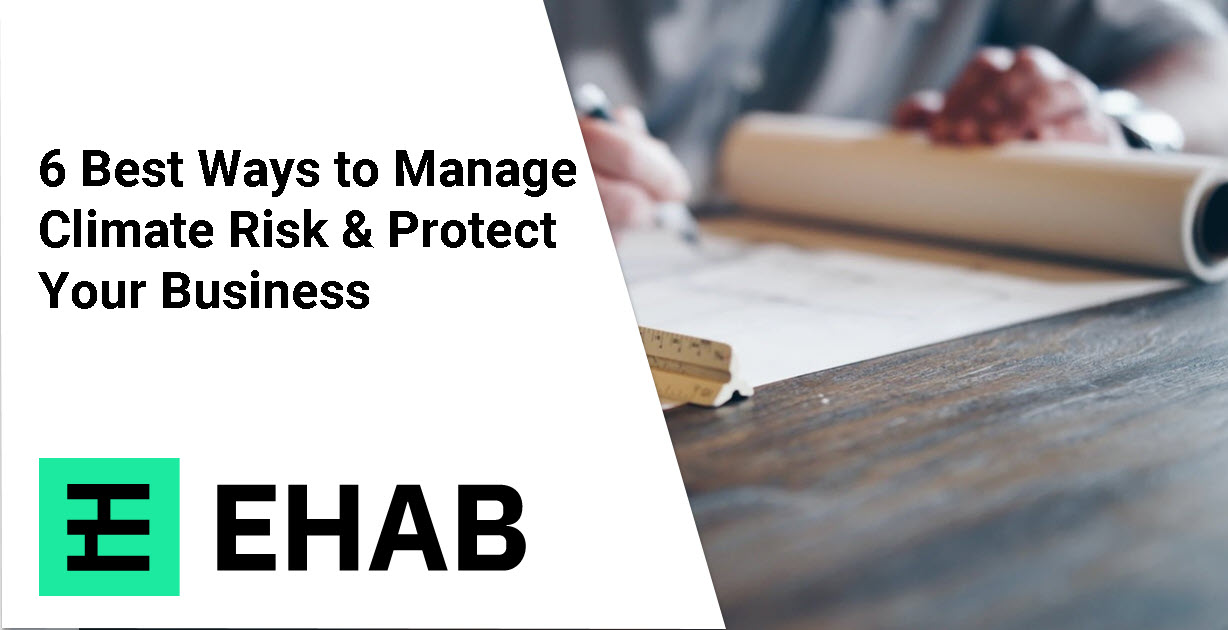Climate risk is the potential adverse effects of extreme weather events such as floods, droughts, heat waves, hurricanes and other natural disasters. Throughout the last 140 years, a startling global temperature increase of 1.1 degrees Celsius has been documented, leading to detrimental effects everywhere. With this heat rise, occurrences such as extreme heat waves and floods are happening more regularly, while prolonged droughts and climbing sea levels continue to be problematic.

(Image source: Mckinsey.com)
These events are causing major disruptions to construction or industrial projects due to damage to infrastructure or supplies, delays in production, or the inability to access certain areas due to safety concerns.
For these reasons, climate risk solutions are an increasingly important consideration for businesses. Companies must manage climate risk appropriately to remain competitive in our ever-changing climate.
Adapting daily operations and investing in climate-resilient technologies are ways businesses can mitigate climate risk and protect their operations from natural disasters or changes in climate patterns. In addition, by having a solid understanding of climate risk and ensuring it is part of decision-making, businesses can ensure they remain successful through times of uncertainty.
As construction and industrial project managers, it is our job to ensure that our projects are completed on time, within budget and with maximum efficiency. But how can we ensure that extreme weather conditions don’t threaten the success of our projects? The answer lies in understanding climate-related risks and developing compelling solutions.
Here are six best practices for managing climate risk.
Understand What Climate Risk Is and How It Can Affect Your Business
The first step in managing climate risk is understanding what it is and how it can affect your business. Climate risk is the potential financial losses associated with extreme weather events or changing weather patterns due to global warming.
Examples include flooding, drought, hurricanes, heat waves, and other extreme weather events that can devastate construction projects. Understanding the potential risks associated with these events will help you identify which areas of your business are most vulnerable so you can develop a plan to mitigate them.
Identify Which Areas of Your Business Are Most Vulnerable to Climate Risk
Once you understand what climate risk is and how it can affect your business, the next step is to identify which areas of your business are most vulnerable so you can target them when developing a risk management plan. Factors such as location, industry sector, and project duration should all be considered when assessing vulnerability. Additionally, consider any existing infrastructure or assets that may be affected by extreme weather events or changing weather patterns due to global warming.
It is best to develop a risk matrix to identify the area's most likely to be affected by climate change. This matrix can include factors such as the probability of occurrence, the severity of impact, and the cost of intervention. This will help you prioritise your climate risk management strategy and focus on high-impact high-severity areas.
Develop a Plan to Mitigate Climate Risk in Those Vulnerable Areas
After identifying which areas of your business are most vulnerable to climate risk, the next step is developing a plan to mitigate those risks. This could include investing in technology that monitors changes in weather patterns or implementing measures such as flood barriers around vulnerable buildings or equipment on site. However, there are many ways you can mitigate climate risk depending on the specific needs of your project or industry sector.
Implement the Plan and Monitor Its Effectiveness Over Time
Once you have developed a plan for mitigating climate risk in vulnerable areas of your business, the next step is implementing it and monitoring its effectiveness over time. This requires regular check-ins with team members responsible for carrying out the plan and tracking progress against set benchmarks for success so that any adjustments can be made swiftly if necessary.
Adjust the Plan As Needed To Ensure Maximum Protection For Your Business
As mentioned previously, regular check-ins with team members who are responsible for carrying out the plan, as well as tracking progress against set benchmarks for success, will enable you to make any necessary adjustments quickly if needed.
However, there may also be times when larger changes need to be made to ensure maximum protection for your business from risks such as floods or heatwaves – for example, installing additional flood barriers around sensitive equipment or relocating certain assets away from high-risk areas. The important thing is to keep an open mind when assessing potential solutions and adjust accordingly if necessary.
Invest in a Weather Risk Management Platform
Finally, investing in a weather risk management platform such as EHAB provides comprehensive climate risk modelling and insights into current conditions, forecasts, and alerts regarding potential severe weather events – allowing businesses more time to prepare themselves before they occur.
In addition, the platform comes with sophisticated features designed specifically with construction projects in mind, helping businesses plan more effectively and better manage extreme weather events.
Climate change poses an ever-increasing threat to construction projects worldwide. In many sectors, companies are now required to make climate related financial disclosures.
Therefore, these best practices all play essential roles in successfully managing climate related risks. By following these steps carefully, construction project managers can take meaningful strides toward safeguarding their operations from costly damages caused by unpredictable climatic conditions.
If you want to learn more about how EHAB can help you manage your climate risks, book a 30-minute no-obligation demo.



